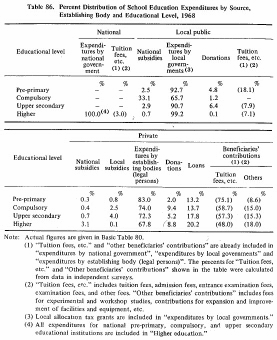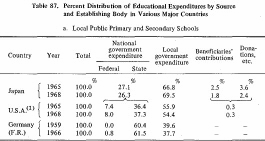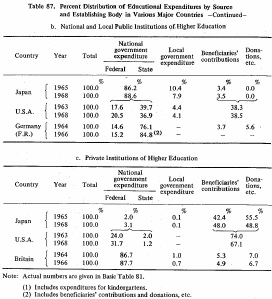| Home > Policy > White Paper, Notice, Announcement > White Paper > EDUCATIONAL STANDARDS IN JAPAN 1971 > CHAPTER |
||
Table 86 analyzes the percent distribution of national, local public, and private school education expenditures, by educational level, for the year 1968.

Note: Actual numbers are given in Basic Table 80. Basic Table 80
When expenditures for local public schools in 1968 are examined, it is noted first that about one third of the expenditures for compulsory schools (primary and lower secondary schools) comes from national subsidies. At other educational levels, national subsidies account for less than three percent of the total expenditures, almost all of which were expenditures by local governments. Seven to eight per cent of the expenditures by local governments for upper secondary and higher education, and eighteen percent of such expenditures for pre-primary education (kindergartens), were from tuition fees, etc. and so the balance after such percents are deducted represents the real expenditures borne by local governments.
As for private institutions, at all educational levels, the share of national and local subsidies is less than three percent, with almost all educational expenditures being those of the establishing bodies (legal. persons), donations and loans. Large percents of these expenditures were, however, represented by beneficiaries' contributions, namely tuition and other fees and other beneficiaries' contributions. In summary, private institutions in Japan depend on beneficiaries' contributions and loans for a large percent of their educational costs.
Table 87 compares school educational expenditures in Japan by source with those in other major countries.

Note: Actual numbers are given in Basic Table 81. Basic Table 81

Note: Actual numbers are given in Basic Table 81. Basic Table 81
In all three countries shown the share of the national government is relatively high in public primary and secondary education expenditures.
The share of the national government for national and local public institutions of higher education, is high in the U.S.A. and Germany (F.R.), where a large percent of such institutions are established by the national or state governments as is the case in Japan. On the other hand, the share of beneficiaries' contributions and donations, etc. is relatively low in Japan and West Germany (F.R.), compared to the U.S.A.
In Britain where there are no national universities and private universities playa public rote, more than eighty percent of the educational expenditures for private institutions of higher education are financed by national subsidies. In private universities in the U.S.A., as well, a relatively high percent of the costs are federally financed, a large percent of which are Federal subsidies for research and Federal funds for research contracts.
| Back to Top | MEXT HOME |